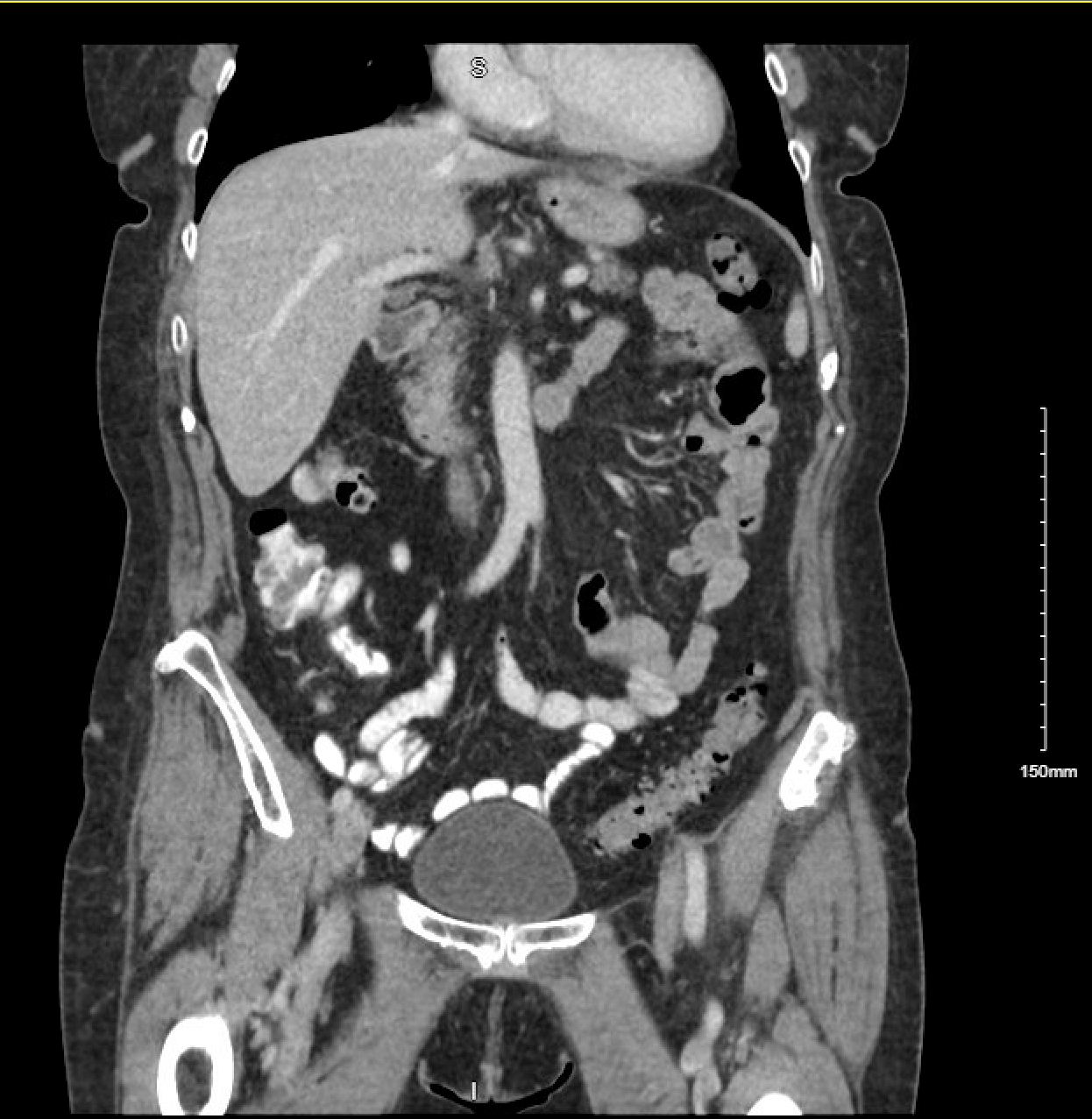Tuesday Poster Session
Category: General Endoscopy
P5174 - Diverticulitis Derived from Diagnostic Colonoscopy
Tuesday, October 28, 2025
10:30 AM - 4:00 PM PDT
Location: Exhibit Hall

Kyle S. Hamann, DO
Riverside Medical Center
Lemont, IL
Presenting Author(s)
Kyle S. Hamann, DO1, Charles Swanson, DO2, Dhaval Patel, DO3
1Riverside Medical Center, Lemont, IL; 2Riverside Medical Center, Kankakee, IL; 3Digestive Disease Consultants, Kankakee, IL
Introduction: Post-colonoscopy diverticulitis is a known, however, rare entity in the world
of endoscopy. One systemic review encompassing three large databases spanning over
three decades acknowledges an incidence of 0.11%-0.37%. Although uncommon, the
potential of post-colonoscopy diverticulitis should be a discussed potential complication
when educating patients on risks and benefits of colonoscopic evaluation.
Case Description/
Methods: A 74-year-old female was initially evaluated outpatient for chronic abdominal
pain and intermittent diarrhea. Laboratory evaluation was largely unremarkable with negative
Cryptosporidium/Giardia, C. Diff, Celiac Serology, Tissue Transglutaminase, Total IgA, Fecal
Calprotectin, Fecal Elastase, and TSH/Total T4. Work up was continued with diagnostic
colonoscopy performed on 1/16/25. The procedure itself was technically difficult as colonoscope
was unable to traverse the sigmoid colon due to angulation. An EGD scope was then utilized to
successfully traverse the sigmoid colon and ultimately reach the cecum. Diverticulosis of the
whole colon was noted with polypectomy being performed on two polyps (3mm-6mm) in both
the ascending and transverse colon respectively. There were no obvious complications noted
right after the procedure. However, the patient did describe experiencing a sharp, left lower
quadrant abdominal pain the day after the procedure was completed and was instructed to
present to the Emergency Department. CT abdomen pelvis with contrast was obtained which
was positive for diverticular changes and mucosal thickening with fat stranding of the sigmoid
colon consistent with acute diverticulitis. The patient was admitted under observation, started on
Zosyn overnight, and transitioned to fourteen-day course of Augmentin for discharge the next
day. Repeat CT abdomen pelvis without contrast was completed roughly one month after
discharge. Imaging showed pan diverticulosis with resolution of diverticulitis.
Discussion: Post-colonoscopy diverticulitis is a rare occurrence. There are a few hypothesized
factors that may contribute to the etiology such as: the direct pressure of the scope, barotrauma
from insufflation, or exacerbation of "silent diverticulitis" [2]. Along with
perforation and appendicitis, post-colonoscopy diverticulitis should be considered in the
differential of any patient presenting with abdominal pain and fever after colonoscopic
evaluation.

Figure: CT abdomen pelvis with contrast depicting colitis of the sigmoid colon
Disclosures:
Kyle Hamann indicated no relevant financial relationships.
Charles Swanson indicated no relevant financial relationships.
Dhaval Patel indicated no relevant financial relationships.
Kyle S. Hamann, DO1, Charles Swanson, DO2, Dhaval Patel, DO3. P5174 - Diverticulitis Derived from Diagnostic Colonoscopy, ACG 2025 Annual Scientific Meeting Abstracts. Phoenix, AZ: American College of Gastroenterology.
1Riverside Medical Center, Lemont, IL; 2Riverside Medical Center, Kankakee, IL; 3Digestive Disease Consultants, Kankakee, IL
Introduction: Post-colonoscopy diverticulitis is a known, however, rare entity in the world
of endoscopy. One systemic review encompassing three large databases spanning over
three decades acknowledges an incidence of 0.11%-0.37%. Although uncommon, the
potential of post-colonoscopy diverticulitis should be a discussed potential complication
when educating patients on risks and benefits of colonoscopic evaluation.
Case Description/
Methods: A 74-year-old female was initially evaluated outpatient for chronic abdominal
pain and intermittent diarrhea. Laboratory evaluation was largely unremarkable with negative
Cryptosporidium/Giardia, C. Diff, Celiac Serology, Tissue Transglutaminase, Total IgA, Fecal
Calprotectin, Fecal Elastase, and TSH/Total T4. Work up was continued with diagnostic
colonoscopy performed on 1/16/25. The procedure itself was technically difficult as colonoscope
was unable to traverse the sigmoid colon due to angulation. An EGD scope was then utilized to
successfully traverse the sigmoid colon and ultimately reach the cecum. Diverticulosis of the
whole colon was noted with polypectomy being performed on two polyps (3mm-6mm) in both
the ascending and transverse colon respectively. There were no obvious complications noted
right after the procedure. However, the patient did describe experiencing a sharp, left lower
quadrant abdominal pain the day after the procedure was completed and was instructed to
present to the Emergency Department. CT abdomen pelvis with contrast was obtained which
was positive for diverticular changes and mucosal thickening with fat stranding of the sigmoid
colon consistent with acute diverticulitis. The patient was admitted under observation, started on
Zosyn overnight, and transitioned to fourteen-day course of Augmentin for discharge the next
day. Repeat CT abdomen pelvis without contrast was completed roughly one month after
discharge. Imaging showed pan diverticulosis with resolution of diverticulitis.
Discussion: Post-colonoscopy diverticulitis is a rare occurrence. There are a few hypothesized
factors that may contribute to the etiology such as: the direct pressure of the scope, barotrauma
from insufflation, or exacerbation of "silent diverticulitis" [2]. Along with
perforation and appendicitis, post-colonoscopy diverticulitis should be considered in the
differential of any patient presenting with abdominal pain and fever after colonoscopic
evaluation.

Figure: CT abdomen pelvis with contrast depicting colitis of the sigmoid colon
Disclosures:
Kyle Hamann indicated no relevant financial relationships.
Charles Swanson indicated no relevant financial relationships.
Dhaval Patel indicated no relevant financial relationships.
Kyle S. Hamann, DO1, Charles Swanson, DO2, Dhaval Patel, DO3. P5174 - Diverticulitis Derived from Diagnostic Colonoscopy, ACG 2025 Annual Scientific Meeting Abstracts. Phoenix, AZ: American College of Gastroenterology.
